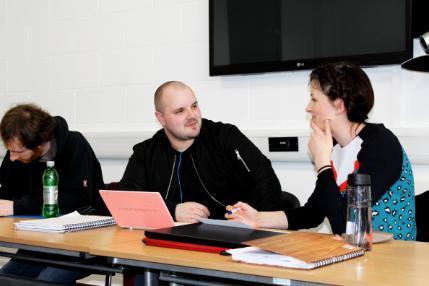Think Pair Share
OVERVIEW

| MODULE TITLE: | Research Methods and Statistics I |
|---|---|
| MODULE COORDINATOR: | Dr Brendan Rooney |
| MODULE CODE: | PSY10100 |
| TARGET AUDIENCE: | Approximately 90 stage one psychology students |
| COLLABORATOR(S): | Dr Suzanne Guerin |
BACKGROUND
Stage one students may not have much experience sitting with uncertainty. And so when first introduced to uncertainty, it brings along its good friend anxiety. Stage one students prefer definite answers and can find the grey areas difficult. This is particularly evident when teaching research methods and statistics to psychology students.
Stage one psychology students tend to be high achievers but can sometimes struggle with statistics perhaps due to a set of preconceptions about what it takes to do well in the subject and their ability to do so. Students who can readily deploy critical thinking to the interpretation of literature, can often struggle to do so when it comes to interpreting data. All this brings a diversity of skill and confidence to the class. As a teacher it can be difficult to know how a particular aspect of a lesson is going. Some students don’t want to show that they do not follow the material, while others are bored from a slow pace (and all levels in between).
GOALS
The goal of the module is to equip students with research understanding and skills. In line with this goal, it aims to empower students to become active learners, who are motivated to search beyond superficial information and test ideas out. To do so, we need to encourage them to get used to uncertainty and see the value in constructing a good question. They already seem to know how important answers are, but the goal of this teaching is to strengthen their research skills through building up their question-muscles. Encouraging students to ask questions, for questions’ sake, elicits reflection on their learning. And as a handy side effect, it enables the teacher to reflect on the students’ learning too.
A frequent challenge here is the anxiety that stage one students can feel about asking questions, about uncertainty, about being judged by their peers and about getting it wrong. The module aims to achieve its goals and combat these barriers by fostering peer-support and collaboration in a research community.
THE INNOVATIVE APPROACH
The technique, an adapted version of the Think-Pair-Share technique, is extremely simple to employ in many settings. It goes like this:
Think
Having talked students through some portion of the topic (and seeing the mental effort in their faces), the class is paused for a moment.
Pair
Students are asked to check-in with the person beside them and explain in their own words what we have just covered. Here they are asked to generate a question or a comment between them. Often the actual question that is generated is not the most important thing, but the search for a question and discussion with their peer encourages reflection. This can be done very quickly in class by allowing them to talk in pairs for about a minute.
Share
Depending on the class or stage, pairs of students can be individually checked-on or questions can be considered out-loud for all the group to hear. Some students are empowered by the pair discussions to ask their question out loud and this can lead to about two to three minutes of discussion for the whole class.
Then the class goes on, but hopefully now with a better understanding of what was just covered and a stable foundation to build upon. After students are used to this technique it becomes less disruptive and the technique can be used many times per hour to punctuate a class.
RESULTS
Using this technique students get used to the process of generating questions and asking them. They feel supported having vetted or generated their question with a peer. It allows stronger students to explain content that was missed the first time. It gives the teacher a sense of how the class is handling the content and what might need fine-tuning. And as a nice side effect, it also gives students a break, or change of pace when there is some dense material.
One of the most encouraging things about this technique is that students who have gotten used to this, didn’t even need to be told to check-in with each other after a while. They simply waited for me to stop talking and they knew it was time to discuss for themselves. I’ve also been encouraged by the student feedback, as evidenced in the following example:
“I found it helpful that during class we were encouraged to ask questions and check with our neighbours for understanding” and “I felt comfortable asking questions which was fantastic”
But of course, the technique is not all good. The class can sometimes move at a slower pace. And because it calls on the students to be active in their learning, they don’t often like it as evidence in other comments…
"Stop the 'checking in with the person beside you' teaching technique, it is not beneficial at all, it disrupts the class and most of us don't understand the course enough to 'check in'."
For this reason the technique works best if students are explicitly told why they are being asked to do this and what the benefits are.